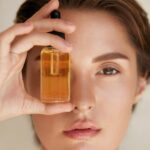
Causes, prevention and treatments for dark circles
The eyes are the first thing that people look at and one of the first facial features that show signs of age and health. Clients are constantly asking us what they can do to diminish dark under eye circles. This has lead to some strong claims and a lot of misleading information about the causes and treatments of dark under eye circles, including some outrageous “DIYs.” It is important to understand there are many types of discoloration under the eyes with different triggers, and therefore different treatment philosophies are needed for each.
The Basics
The actual tissue under and around the eye is very thin and delicate and has no oil glands of its own. It is a thin veil over the intersection of several systems; ocular nerves, lymphatic nodes, avenues of blood flow to the eyes and the fulcrum of the sinuses. With all of this activity in this one area, there are many systems at play and special attention needs to be given to any analysis and treatment of that area.
To really figure out how to treat something, we need to first identify what it is and what is causing it. When it comes to darkness under the eyes, there are several different types and reasons why we have them. Until you can identify the cause or trigger, you can never effectively combat the issue. Here are some potential causes for discoloration under the eyes and dark circles:
- Allergies
- Genetics
- Pigmentation
- Lifestyle
- Rubbing or touching the eyes
- Aging and thinning skin
In all cases, an increase in water intake, a healthy diet, plenty of good sleep and a reduction of stress are imperative to effectively treating darkness under the eyes. Let’s discuss each of these in more detail:
Genetics
Some people present dark under-eye circles that look like bruises. These range in color from a light pinkish discoloration to a dark purple bruise-like discoloration under the skin that tends to radiate out from the center, next to the nose and to the outside of the eye. In these cases, genetics plays a strong roll. In many cases, this discoloration is also accompanied by a fatty deposit that gets larger with age.
This condition usually presents itself in young adults and gradually gets worst with age. In many cases, it is a simple issue of poor lymphatic and blood circulation.
There are some preventative methods for this condition, but it is difficult to avoid entirely. There are massage methods to help with circulation, topical manipulations to help with activating the lymphatic system and topical applications that can be used to improve the condition. Diet can also play a large role in keeping the body toxin free and therefore reducing the discoloration around the eye.
Eventually, the client might consider a minor surgery to remove the fat deposits and alleviate the blood flow to and from the area. In many ways, it is like a treatment of a hematoma with the long term repetitive management.
There are some topical formulations that have shown strong benefits in the alleviation of discoloration, such as Hesperidin Methyl Chalcone to improve vascular flow and Dipeptide-2 to improve lymphatic function. There is no way of reducing the actual fat deposit without surgery. Beware of any laser or ultrasound treatments that promote the treatment around the eye. Although they might be effective in other areas of the body, the eyes are too delicate and should never be put at risk.
Lifestyle
Our lifestyle directly affects our skin. Issues such as physical or emotional stress, smoking, or chronic alcohol use can take a toll on your overall appearance with a special emphasis on the skin around the eye. It is the most delicate and therefore the first to react.
Lifestyle is a huge factor in everything that has to do with the body. As estheticians, we should always conduct a lifestyle assessment and talk to our client about how their choices affect their skin and impact their ability to effectively get the results that they are looking for. Remember, it is not our job to judge or tell them what to do. We are charged with educating our clients and gently guiding them to intentional decisions that balance their lifestyle choices with their skin care goals.
The treatment here really does revolve around the actual lifestyle choices. A very thorough assessment needs to be done with a clear analysis; this subsequently needs to be maintained through additional treatments and home care recommendations. In most cases with stress and physical exhaustion, something topically soothing and nutrient-dense is a good hedge until the lifestyle changes can become visible.
Pigmentation
In many cases, the darkness that presents itself is simply more melanin in the skin. This type of dark circle is more prevalent and of a particular concern for people of color.
This is a common condition in darker skinned and olive toned clients. A word of caution here is that just because it is an issue on the main part of the face does not mean it can be treated in the same manner. Therapies and ingredients that work on the thicker surrounding skin will not have the same effect around the eyes because of the difference in skin tissue structure. If you attempt to treat the eyes in the same way you would treat the face, you could actually be triggering more damage.
When it comes to treating pigmentation irregularities around the eyes, progressive is better than aggressive. Start gently and slowly. If the pigmentation is triggered by hormones or medication, then gently protect the skin from any sun damage that could exacerbate the situation until the triggers are out of the system. Remember, it takes the body roughly 35-40 days to communicate between the skin and the brain. This is especially true for oil production, hormone production and toxin evacuation. If the discoloration stems from sun damage, then develop a series of gentle exfoliations, coupled with a very precise bleaching regimen. Sun protection is imperative.
Aging and Thinning Skin
As clients age, hormone changes cause the skin to thin. This can make the reddish-blue blood vessels under the eyes more obvious. This thinning of the skin happens to both men and women, but accelerates more as women enter menopause.
Collagen failure or collapse is what causes flaccid or loose skin. It is also associated with a bright blue discoloration under the eyes. Prevention is the best way to treat this condition. Although it is inevitable, you can try to postpone it for as long as possible by educating your client on lifestyle choices, topical applications, home care and sun protection.











